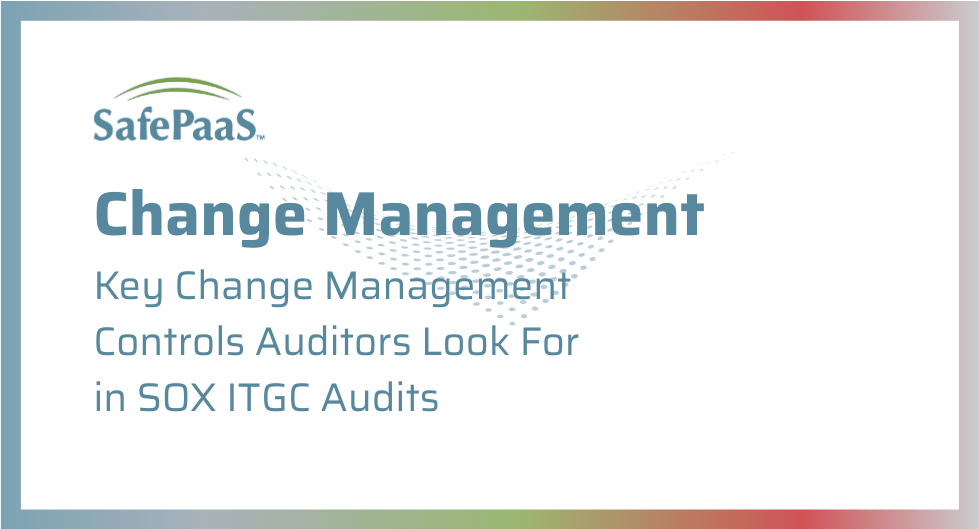Why You Need Advanced, Independent Change Management Platforms
Picture yourself preparing for your annual SOX audit, confident that your change management controls are solid, until you realize that entire business units and critical applications have slipped outside your compliance perimeter.
As the audit deadline approaches, weaknesses created by disconnected, manual, or ERP-centric processes suddenly become glaringly obvious. Risks that were hidden in plain sight now threaten not just your audit outcome but your organization’s financial integrity and brand.
Manual change management processes are particularly problematic at every step:
- They are prone to human error, leading to unauthorized changes and operational disruptions.
- Manual approvals and documentation create bottlenecks, slowing down response times and increasing the risk of missed deadlines.
- Tracking changes by hand often results in incomplete audit trails, exposing you to compliance failures.
- The lack of centralized visibility and standardized workflows makes it difficult to enforce segregation of duties or quickly detect and remediate risks.
- These inefficiencies not only increase operational costs but also frustrate staff and divert resources from strategic initiatives.
Traditional ERP-native change management tools can leave you exposed in complex enterprise environments. In this guide, you’ll learn which controls auditors now expect, where the most common compliance deficiencies and vulnerabilities arise, and what capabilities are essential for achieving audit-ready change management across your entire business.
If you’re responsible for SOX ITGC controls, this guide will help you identify and address weaknesses before your next audit so that every change is tracked, every risk is surfaced, and every audit is passed with confidence.
1. Why Change Management Controls Matter for SOX
Change management is essential to ensure that every modification to systems impacting financial reporting is authorized, tested, documented, and reviewed. Weaknesses in your process can lead to unauthorized changes, data corruption, and operational disruptions, threatening SOX compliance and increasing audit risk. As audit and regulatory scrutiny intensifies, you need solutions that go beyond the basics to provide comprehensive, enterprise-wide risk mitigation.
To understand the scope of what’s at stake, consider these core business processes and systems that directly influence financial statement accuracy:
|
Process/System |
Role in Financial Statement Accuracy |
|
Inventory Management |
Maintains precise records of inventory levels and valuation, directly affecting reported assets and cost of goods sold. |
|
Billing |
Ensures correct invoicing and revenue recognition, which is essential for accurate income reporting. |
|
Payroll Processing |
Calculates and disburses employee compensation, impacting reported expenses and liabilities. |
|
Accounts Receivable & Accounts Payable |
Tracks incoming payments and outgoing obligations, shaping the company’s liquidity and financial position. |
|
Sales Order Processing |
Manages the fulfillment and recording of sales, influencing revenue recognition and related disclosures. |
|
Expense Reporting |
Captures and documents business expenditures that affect the company’s reported net income and operating costs. |
|
Fixed Asset Management |
Oversees the acquisition, depreciation, and disposal of assets, which is vital for accurate asset valuation and expenses. |
|
Financial Reporting Software |
Consolidates and presents financial data, serving as the backbone for producing compliant and reliable statements. |
2. Core Change Management Controls Auditors Expect
Auditors expect a strong set of controls throughout your change management process. These include:
- Change Authorization: Formal, multi-level approval workflows for all system changes.
- Segregation of Duties: Fine-grained separation of responsibilities and automated detection of SoD conflicts.
- Change Testing and Validation: Rigorous, documented testing before deployment.
- Change Documentation: Comprehensive, consolidated documentation from request to deployment.
- Emergency Change Procedures: Expedited but controlled processes for urgent changes.
Modern platforms automate and unify these controls, eliminating the manual gaps that often lead to compliance deficiencies.
3. The Risks of Manual Change Management
Continuing to perform change management tasks manually introduces significant business risks at every step:
- Error-Prone Execution: Repetitive data entry and manual tracking are susceptible to mistakes, leading to unauthorized or incomplete changes.
- Delays and Bottlenecks: Manual approvals and documentation slow down change cycles, delaying critical business initiatives.
- Audit and Compliance Failures: Incomplete or inconsistent records make it difficult to provide a comprehensive audit trail, increasing the risk of failed audits and regulatory penalties.
- Lack of Visibility: Without centralized tracking, it’s challenging to monitor the status of changes or enforce accountability.
- Resource Drain: Manual processes require significant administrative effort, diverting skilled staff from higher-value work.
- Inconsistent Quality: Lack of standardization leads to variability in change execution and testing, increasing the risk of failed changes and outages.
- Employee Frustration: Tedious manual tasks frustrate IT and business staff, impacting morale and retention.
4. What You Should Expect from a Modern Change Management Platform
A modern change management platform should provide the following capabilities:
- Multi-application coverage: Unified governance across all critical business systems.
- Fine-grained risk and SoD analysis: Entitlement-level reviews and a continuously updated risk library.
- Automated, documented workflows: End-to-end automation for approvals, testing, and deployment, with full traceability.
- Full identity lifecycle management: Automated tracking of movers, leavers, and joiners across all systems.
- Integrated incident management: Consolidated audit logs, incident workflows, and closed-loop remediation.
- ITSM and provisioning integration: Out-of-the-box connections to ServiceNow, Jira, and other tools.
- Independence and audit integrity: Operation as a standalone platform, ensuring audit evidence cannot be altered by privileged users.
- Continuous innovation: Rapid adaptation to new risks and compliance mandates.
5. The Business Value of Automating Change Management at Every Step
Automating your change management process delivers measurable business value by addressing the pain points of manual processes:
|
Change Management Step |
Manual Process Problems |
Value of Automation |
|
Change Request Initiation |
Lost/misrouted requests, lack of triage |
Centralized intake, automated triage, standardized requests |
|
Approval Workflow |
Delays, bottlenecks, inconsistent approvals |
Automated routing, faster approvals, full audit trail |
|
Development & Testing |
Poor documentation, missed steps, error-prone |
Enforced workflows, required evidence, automated sign-off |
|
Migration & Verification |
Unauthorized or untested changes |
Controlled deployments, automated checks, rollback capability |
|
Documentation & Audit Trail |
Scattered/incomplete records, hard to audit |
Centralized, tamper-proof logs, real-time dashboards |
|
Incident Management |
Slow detection, manual remediation, missed issues |
Automated alerts, workflow-driven remediation, traceability |
|
Lifecycle Management |
Orphaned/dormant accounts, SoD conflicts |
Automated onboarding/offboarding, privilege analytics |
Key benefits of automation include:
- Reduced human error and increased consistency
- Accelerated change delivery and business agility
- Enhanced compliance and audit readiness
- Improved visibility and accountability
- Lower operational costs and resource optimization
- Scalability as business needs grow
- Higher employee satisfaction and retention
6. Best Practices for Audit-Ready Change Management
To achieve audit-ready change management, automate and orchestrate your processes wherever possible. Platforms that automate approvals, testing, documentation, and audit trail generation across all systems help you reduce manual effort and the risk of oversight. Centralizing evidence is equally important; by consolidating logs, tickets, and workflows, you create a single source of truth that’s always ready for auditor review.
Enforcing segregation of duties and sensitive access controls is another best practice. Privilege-level analytics allow you to detect and remediate risks before audits rather than reacting after the fact. Seamless integration with ITSM, provisioning, and identity platforms provides end-to-end traceability, ensuring that every change, approval, and exception is fully documented.
Maintaining independence is crucial for protecting audit evidence from tampering. Platforms architected for compliance safeguard your data and provide confidence in your audit results. Finally, continuous improvement is key—choose solutions that can rapidly adapt to new risks and compliance mandates so you’re always prepared for what’s next.
7. A Modern Change Management Process in Action
An audit-ready change management process should begin with change request initiation, where a ticket is raised in your ITSM system and triaged for risk and impact. The approval workflow should then route automated, multi-level approvals to the appropriate stakeholders, with the complexity of the change determining the level of scrutiny required.
As changes move through development and testing, each stage should be tracked, with evidence and results documented to ensure accountability. Migration to production should be tightly controlled, incorporating independent verification and post-implementation review to catch any discrepancies or issues.
Throughout the process, documentation and audit trails are centrally logged, creating a tamper-proof, consolidated record of every action, approval, and artifact. Integrated incident management ensures that any exceptions or risks are automatically flagged, remediated, and documented. Finally, lifecycle management processes continuously govern user access and identities, with automated onboarding, offboarding, and privilege adjustments across all systems to prevent the accumulation of unnecessary access.
When you rely on legacy or ERP-native tools for SOX change management, your organization may be exposed to compliance deficiencies and audit vulnerabilities. As audit expectations rise and your business environment grows more complex, it’s worth considering whether your current approach delivers the enterprise-wide coverage, fine-grained risk analysis, and audit-ready documentation needed for today’s regulatory landscape.
By exploring advanced, independent platforms with these capabilities, you can more effectively address discrepancies, reduce audit risk, and support continuous, defensible SOX compliance—no matter how complex your IT landscape becomes.
Evaluate your current change management controls against these benchmarks. If you identify deficiencies in coverage, risk detection, or auditability, now is the time to consider a modern, independent platform designed for today’s enterprise compliance challenges.


